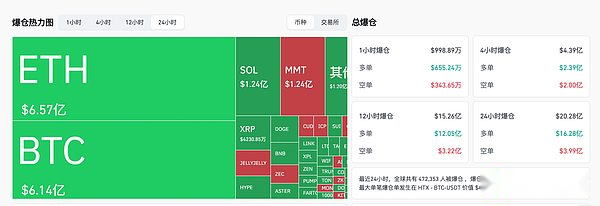
Shaw, Bitcoin Vision
On November 5, crypto assets such as Bitcoin and Ethereum continued to be weak and continued to fall.Bitcoin fell below the $100,000 mark for the first time since June, falling below $99,000 in the early morning, a 24-hour drop of more than 7%;Ethereum briefly fell below $3,100 in the early morning, a 24-hour drop of more than 13%.Mainstream altcoins such as BNB and SOL also continued to fall sharply.Subsequently, Bitcoin and Ethereum rebounded slightly.In the past 24 hours, the entire network was liquidated to US$2.028 billion, of which long orders were liquidated to US$1.628 billion and short orders were liquidated to US$399 million.
Only one month has passed since Bitcoin hit a new high, and the crypto market is showing signs of weakness, especiallyAfter entering November, the market is filled with grief, and “the bull market is over” remarks are common., in the endWhat factors have negatively affected the market? Is the bull market really over??
1. BTC fell below the important support of US$100,000, and the crypto market continued to be weak.
Cryptocurrency assets such as Bitcoin and Ethereum continued their weakness on November 5 and continued to fall.Bitcoin fell below the US$100,000 mark for the first time since June. It fell below US$99,000 in the early morning and briefly touched US$98,944, a 24-hour drop of more than 7%. Ethereum once fell below US$3,100 in the early morning and briefly touched US$3,057, with a 24-hour drop of more than 13%.Mainstream altcoins such as BNB and SOL also continued to fall sharply.Subsequently, Bitcoin and Ethereum rebounded slightly, with Bitcoin rebounding to around US$101,000 and Ethereum rebounding to around US$3,300.
Coinglass data shows,In the past 24 hours, the entire network was liquidated to US$2.028 billion, and more than 472,000 people were liquidated, including US$1.628 billion for long orders and US$399 million for short orders., the main force is to explode multiple orders.ETH was liquidated to US$657 million, BTC was liquidated to US$614 million, and SOL was liquidated to US$124 million.

Since the “10.11” largest drop in history and the liquidation event, the crypto market has lacked sufficient momentum to rebound, and it once fell below the important support level of $100,000 early this morning.Although many people are still bullish on the direction of crypto assets by the end of the year,Continued downward pressure puts a big question mark on whether the crypto bull market can continue..
2. ETF and DAT treasury funds are withdrawn, and the market loses its main driving force
enterSince November, ETF funds have continued to experience net outflows, and funds from digital asset treasury (DAT) reserve companies have also withdrawn..According to Lookonchain monitoring,In the first two days of this week, 10 Bitcoin ETFs had a total net outflow of 3,710 Bitcoins.(worth $393.67 million),9 Ethereum ETFs had net outflows totaling 59,855 Ethereums(worth $216.45 million).Farside Investors data shows that the U.S. Bitcoin spot ETF saw a net outflow of US$799 million last week, and the Ethereum spot ETF experienced net outflows for three consecutive days last week, with a total outflow of US$363 million.
Represented by StrategyThe buying pace of Bitcoin treasury companies has slowed significantly.Strategy increased its holdings of approximately 43,000 Bitcoins in the third quarter, which was the company’s lowest quarterly purchase volume so far this year.Sequans Communications, a US-listed semiconductor company, redeemed 50% of its convertible bonds by selling 970 Bitcoins.The deal reduces the company’s total debt from $189 million to $94.5 million.Sequans currently holds 2,264 Bitcoins, a decrease from the previous 3,234.At current market prices, the company’s Bitcoin net asset value is approximately $240 million, with its debt-to-NAV ratio falling from 55% to 39%.MetaPlanet, a Japanese Bitcoin treasury company, recently saw its share price fall below the market value of its Bitcoin holdings after experiencing a sharp decline.According to official news, MetaPlanet has completed a 150 million common stock repurchase plan.
The two major factors of ETF and DAT treasury are one of the main driving forces of this bull market.The cautious wait-and-see of institutional investors and the departure of funds have caused the crypto market to lack sufficient upward momentum and instead continue to fall..(See Bitcoin Vision’s previous article “The largest buyer of BTC stopped accumulating large amounts of holdings and ETF capital inflows were weak. Is this the reason for the sharp decline of BTC?》)
3. Whale leveraged contracts were traded frequently, and large orders were liquidated.
During the ongoing decline in the crypto market, whale investors’ previously large long orders were liquidated again.Monitored by on-chain analyst Ai Ai (@ai_9684xtpa),The remaining long orders of the previous “100% Winning Whale” were cleared early this morning, resulting in a loss of US$39.37 million.BTC fell below 100,000 US dollars in a short period of time, and ETH fell to 3,057 US dollars, quickly falling to its liquidation line; the multi-order operations that began on October 24 accumulated losses of 39.906 million US dollars, and the overall loss of its account reached 30.02 million US dollars.
On-chain analyst Ember Monitoring, oneThe giant whale, which had previously been long a total of 1,320 WBTC (approximately US$132 million) through revolving lending, has approached the liquidation line after the market fell..In order to reduce risks, the giant whale sold approximately 465.4 WBTC and 2,686 ETH this morning, in exchange for a total of approximately US$56.52 million USDC to repay part of the loan.Lookonchain monitoring,“Big Brother Maji” Huang Licheng’s long orders were completely liquidated again.His account balance is now only $1,718.
In addition, Onchain Lens monitoring,A giant whale deposited 3.5 million USDC into HyperLiquid and shorted BTC and ETH with 20 times leverage.
Whale investors frequently conduct contract transactions with high leverage, greatly exacerbating the short-term volatility of the crypto market, while large multi-order liquidations exert a stronger downward force on crypto assets and exaggerate the fragility of the market..
4. Macroeconomic factors such as the “shutdown” of the U.S. government and the pending interest rate cut by the Federal Reserve have drained liquidity.
The U.S. government “shutdown” crisis continues with no sign of resolution.According to Xinhua News Agency, the U.S. Senate once again failed to pass a temporary federal appropriation bill on the 4th, which means that this round of federal government “shutdown” is about to break the historical record of 35 days of “shutdown” from the end of 2018 to the beginning of 2019, becoming the longest government “shutdown” in U.S. history.The U.S. Congressional Budget Office recently stated that if the “shutdown” lasts for four weeks, the U.S. economy will lose $7 billion; if it lasts for six weeks, the loss will rise to $11 billion; if it lasts for eight weeks, the loss will be as high as $14 billion.
The change in the direction of the Fed’s policy is another straw that breaks the market.The hawkish remarks made by Federal Reserve Chairman Powell last week downplayed market expectations for a December interest rate cut and once again strengthened the narrative that interest rates will “remain high for longer.”This shift has pushed the U.S. dollar stronger, putting direct pressure on non-interest-bearing assets such as Bitcoin.
BitMEX founder Arthur Hayes said in this regard that the U.S. Treasury Department is borrowing money but not spending it. The Treasury Department’s general account is about $150 billion higher than the target of $850 billion. This additional liquidity will not be released into the market until the government reopens.This liquidity drain is one of the reasons for the current weakness in the crypto market.Expect market volatility, especially until the U.S. government shutdown ends.Many people will mistake this period of market weakness and dullness for a top and sell off their positions, which is a mistake because the mechanics of the USD currency market don’t lie.Not only does Bessant need to issue $2 trillion a year to fund the government, it must issue trillions more to roll over maturing debt, and stealth quantitative easing through the SRF will begin soon.(See Bitcoin Vision’s previous article “Arthur Hayes: The U.S. government shutdown is one of the reasons for the current weakness in the crypto market. Please be patient and wait for the invisible QE》)
5. Protocol vulnerability attacks occur frequently and market panic intensifies
After balancer was hacked and lost more than $100 million on November 3, other projects suffered vulnerability attacks.CertiK monitoring,Moonwell lending contract suffered multiple attack transactions.The attacker used the wrst price (approximately $5.8 million) returned by the incorrect oracle to make a flash loan of only approximately 0.02 wrstETH and deposit it, repeatedly lending more than 20 wstETH, and making a profit of 295 ETH (approximately $1 million).
In addition, on November 4, according to PeckShield monitoring,The pledged stablecoin Staked Stream USD (token symbol $XUSD) has been unanchored, a drop of approximately 23%.Stream Finance officials subsequently stated that an external fund manager disclosed that the Stream funds under his supervision had lost approximately US$93 million.Stream has hired Keith Miller and Joseph Cutler of law firm Perkins Coie LLP to lead a comprehensive investigation.Stream is withdrawing all liquid assets and announced the suspension of all deposit and withdrawal operations.
Cryptocurrency markets were already vulnerable to mass liquidations in October, andA series of protocol vulnerability attacks and asset anchoring incidents have exacerbated this vulnerability..
6. Is the bull market over? Market analysis and interpretation at a glance
After a series of declines in cryptocurrencies, is the bull market over?Will the market continue to fall, or rebound and rise?Let’s take a look at the main interpretation and analysis.
1. Matt Hougan, Chief Investment Officer, BitwiseSaid that although retail investors are in a state of “maximum despair”, he believes that this means that the market bottom may be about to appear, rather than being far away.With the support of Bitcoin from Wall Street institutional investors and financial advisors, as well as the growth of cryptocurrency ETFs, he even boldly stated that amid the current violent sell-off, it is not impossible for Bitcoin to reach a record high before the end of the year.Hougan believes that more crypto trading is gradually shifting to institutional-dominated markets.
2. Eric Balchunas, Bloomberg ETF AnalystThe article stated that the growth of Bitcoin ETF will go through a process of two steps forward and one step back, and is now in the retreat stage.This pattern can be seen in IBIT’s capital flows.In my opinion, this is part of the development process.Only a child would expect a daily rise.
3. DeFiance Capital founder @Arthur_0xHe tweeted that he entered the cryptocurrency field in 2017, and the current situation is comparable to that from late 2018 to 2019. It is the most severe market environment faced by cryptocurrency market participants.Now, survival is king.
4. Cryptocurrency market maker WintermuteThe article states that although the macro environment remains supportive, including interest rate cuts, the end of quantitative tightening, and stocks near highs, cryptocurrencies continue to lag other asset classes.Wintermute noted that global liquidity is expanding, but funds are not flowing into the cryptocurrency market.Of the three major inflow engines driving performance in the first half of the year, only stablecoin supply has continued to grow, while ETF inflows have stalled since the summer, with BTC ETF assets under management hovering around $150 billion and digital asset trading (DAT) activity also drying up.Wintermute believes that the four-year cycle concept is no longer applicable to mature markets and that liquidity is the key factor currently driving performance.ETF inflows and DAT activity will be closely monitored and will be important signals of liquidity returning to the cryptocurrency market.
5. CryptoQuant dataIt shows that the Stablecoin Supply Ratio (SSR) has fallen back to the 13-14 range.Historically, this level has marked a liquidity inflection point in the market many times – when stablecoin balances increase relatively, it means that OTC “purchasing power” is building up.Bitcoin is currently trading near $100,000, and the lower SSR suggests stablecoin liquidity may be quietly rebuilding.Analysts believe that this may pave the way for a retaliatory rebound or the final bull market of this cycle.
6. Elon Gu, senior analyst at Ultima MarketsIt is pointed out that from a technical perspective, if Bitcoin wants to reverse upward, it must first regain the 21-day exponential moving average (EMA) and the transaction-intensive area at about $111,000.Above this, $116,000 will be the next key resistance level.
7. Analyst @ali_chartsAccording to glassnode’s Bitcoin UTXO realized price distribution chart analysis, Bitcoin is below $104,800, and the number of UTXOs (unspent transaction outputs) supporting the price is small.
8. Michael Saylor, founder of StrategySaying that Bitcoin will “forever” rise at 20% per year, “I call it the global reserve capital network.”
9. Market Analyst Damian ChmielIt is pointed out that if the price of Bitcoin continues to be below $100,000, it may trigger a sharper sell-off, and the next target will be April’s low near $74,000, which means there is still about 30% potential downside from current levels.
10. Kris Marszalek, founder and CEO of Crypto.comHe said that any way to bring more funds into the industry is also a good thing, but reminded that “99% of such companies will return to zero. If you want to invest, you must be very picky and choose the right ecosystem and a long-term vision, rather than just wanting to speculate quickly.”Kris Marszalek advises investors to be cautious and investing in digital asset reserve tokens is like investing in a startup angel round.






